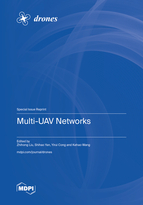Multi-UAV Networks
A special issue of Drones (ISSN 2504-446X).
Deadline for manuscript submissions: closed (31 May 2023) | Viewed by 26822
Special Issue Editors
Interests: multi-UAV systems; UAV swarms; cooperative decision and control
Special Issues, Collections and Topics in MDPI journals
Interests: UAV-aided communications; covert communications; covert sensing; location spoofing detection; physical layer security; and IRS-aided wireless communications
Special Issues, Collections and Topics in MDPI journals
Interests: control theory; communication theory; filtering theory
Special Issues, Collections and Topics in MDPI journals
Interests: stochastic optimization; operation research; scheduling; wireless network communications; embedded operating system
Special Issues, Collections and Topics in MDPI journals
Special Issue Information
Dear Colleagues,
Nowadays, multi-UAV systems have been revealing great potential values in applications such as surveillance, disaster rescue, mapping, cargo delivery, etc. Through coordination among multiple or even a swarm of UAVs, multi-UAV systems can improve the mission capability, survivability, and flexibility. Regarding the key technologies, Multi-UAV networks are the essential building blocks in multi-UAV systems, which provide the foundation for information transmission and further enable team behavior. Although the emergence of 5G and FANET (Flying Ad hoc Network) provides options for improving the Quality of Service (QoS) in multi-UAV networks, the off-the-shelf wireless networks are still not well suited for agile networks. Issues such as unpredictable latency and jitter, and high variance in throughput, may arise, in particular when the scale of the UAVs tends to be large. Besides, the networking and the control problems cannot be isolated while improving the overall performance of multi-UAV systems. How to develop key techniques for the control and navigation of multiple UAVs over wireless networks becomes a necessity, which raises many theoretical and practical open problems in the cross fields of control, estimation, and communications.
The Special Issue solicits key theoretical and practical contributions to networking as well as the control problems for multi-UAV systems. It aims to bring the studies from related fields (control, navigation, and networking) together.
We solicit high-quality original research papers on topics including, but not limited to:
- Multi-UAV Swarms in 5G Networks
- Reliable Wireless Networks for Multi-UAV Systems
- Delay-tolerant Networking (DTN) protocols for Multi-UAV Systems
- Software Defined Networks (SDN) assisted UAV Networking
- Cooperative Control of Multi-UAV Systems
- Networked Control Under Communications Constraints
- Localization of Mobile Nodes in Wireless Networks
- Filtering/Distributed Filtering Theory and Applications
- Adaptive/Learning-based Observer and Parameter Estimation
- Task Scheduling of Multi-UAV Systems
- Interference Management of Multi-UAV Systems
- Resource Allocation of Multi-UAV Systems
- Multi-Function Device of Multi-UAV Systems
Dr. Zhihong Liu
Dr. Shihao Yan
Dr. Yirui Cong
Dr. Kehao Wang
Guest Editors
Manuscript Submission Information
Manuscripts should be submitted online at www.mdpi.com by registering and logging in to this website. Once you are registered, click here to go to the submission form. Manuscripts can be submitted until the deadline. All submissions that pass pre-check are peer-reviewed. Accepted papers will be published continuously in the journal (as soon as accepted) and will be listed together on the special issue website. Research articles, review articles as well as short communications are invited. For planned papers, a title and short abstract (about 100 words) can be sent to the Editorial Office for announcement on this website.
Submitted manuscripts should not have been published previously, nor be under consideration for publication elsewhere (except conference proceedings papers). All manuscripts are thoroughly refereed through a single-blind peer-review process. A guide for authors and other relevant information for submission of manuscripts is available on the Instructions for Authors page. Drones is an international peer-reviewed open access monthly journal published by MDPI.
Please visit the Instructions for Authors page before submitting a manuscript. The Article Processing Charge (APC) for publication in this open access journal is 2600 CHF (Swiss Francs). Submitted papers should be well formatted and use good English. Authors may use MDPI's English editing service prior to publication or during author revisions.
Keywords
- multi-UAV systems
- UAV networking
- UAV communications
- cooperative control
- networked control
- navigation









